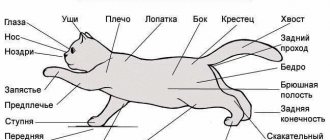Fennec fox: appearance, description
The fennec fox is a small animal, smaller than a cat. Body weight reaches 1.5 kg, and length - 40 cm. Natural habitat - the northern part of the African continent and the Arabian Peninsula.
Fenech is the only predatory animal that has large ears, the size of which is disproportionate to the head. They are necessary for a small animal to adapt to living in a desert area. Thanks to their surface, increased heat transfer occurs, and the fox does not overheat. The size and shape of the ears helps the fennec to hear well, so it quickly finds prey in the wild.
Down grows on the paws of the eared animal. It allows the fennec to move freely on the hot sand and not get burned. The animal's skin is orange and in its natural habitat it blends in with the sand. This is his advantage in hunting. The potential victim does not notice the fennec cat, but he manages to attack.
Who is Fennec?
The fennec fox is a small animal, its homeland is considered to be North Africa. Belonging to the canine family, their size is small, they are smaller than domestic cats.
The weight of the fennec cat does not exceed 1.5 kg, the main feature is large ears measuring 15 cm, and the body itself is only 30 cm long. Such a non-standard ear size is necessary to maintain temperature; the large area of the ears and blood vessels cools it in the heat.
Fennec foxes are born with a white color, which later changes to red or fawn. The fur is very long and soft. The animals' inherent jumping ability allows them to jump up to 70 cm in height and a distance of 1 meter.
Forming packs, foxes hunt one at a time. They live in burrows with a complex pattern of passages. One night is enough for the fennec to dig a hole 5 m long.
Foxes do not tolerate cold very well, so during frosty periods they need to be provided with warmth. Because of the cold, the animal often develops problems with its eyes; if it catches a cold, it can die.
The difficulty of taming an animal depends on the age at which it appeared in the house. At first the animal will need a lot of attention; you should not shout at it, as it may get scared.
Wildlife Habitat
The fennec fox lives in places with high air temperatures. For living, the animal chooses thickets of grass or small bushes. It digs holes in the ground in which entire families live, usually up to 10 individuals. The animal is predominantly nocturnal.
Hunts prey alone. It is considered an omnivore because it digs most of its food from the sand. The diet includes insects, fruits and plant rhizomes. Thanks to its excellent hearing, the fennec catches every rustle. No matter where foxes live, they are good hunters.
The lop-eared fox can remain without water for a long time. The animal obtains the moisture necessary for life from food. Knows how to store food. Capable of high jumping up to 70 cm.
How to make your home safe for fennec cats?
Make sure that electrical wires and sockets are not accessible to your fennec cat. Floors should always be clean: any small objects that the fox finds on the floor can be swallowed by him.
Do not leave breakable or fragile things where the fox can reach them. Fenech can easily jump even on a fairly high table.
To avoid an accident, do not forget to close the toilet lid.
Even a plastic bag carelessly left on the floor will cause a curious fennec to try to explore and play with it. This will most likely end with the animal getting tangled in the handles.
Lock your windows and front door, otherwise you risk never seeing your pet again.
Many Fennecs love to dig through garbage bags or have a particular predilection for pieces of furniture or carpets. You can give your fennec a gift - give him an old sofa, in which he will definitely dig a hole.
They love to chew on metal things (buttons, coins, etc.). Keep in mind, this is very dangerous for animals, they should not have access to such things. Another passion of theirs is things made from rubber and leather. If an animal swallows such an object, it may need emergency veterinary attention.
Eared fox as a pet
Buying a fennec tree cheaply is difficult, but possible. Keeping a live lop-eared fox at home is more difficult than keeping a cat or dog. He needs special conditions. And we must not forget that the fox is still a wild animal.
To keep a home, you can only buy a fox of this breed. Only the fennec can adapt to living at home. In order for him to feel good and not get sick, when organizing care, you need to take into account the following features:
- It is always necessary to maintain a high temperature in the room - the pet does not tolerate cold well;
- in the absence of the owners, the fennec cat must be locked in a spacious enclosure;
- can be kept at the same time as other pets;
- You should not start if there are small children in the family;
- protect from loud sounds, as this can damage the animal’s delicate hearing;
- protect from bright light.
It is better to take the animal when it is still a cub, it is easier to raise it this way. The price for a baby may be higher than for an adult, but it will be easier to form the pliable character of a fox cub from a young age. Chanterelles are shy and difficult to train.
Fenech quickly gets used to the tray. Timely vaccination is necessary. The drugs used are the same as for dogs.
The little fox will be happy if a tray with sand is organized for him. Despite living at home, the instinct to build burrows does not disappear. To save furniture from the teeth and claws of an animal, you need to purchase special toys that are sold in pet stores.
Animal care
A person should spend a lot of time raising a Fenech. But caring for a fox is completely simple - no more difficult than caring for a dog or cat.
Grooming
Domestic foxes, although considered exotic, are very undemanding. Their thick fluffy fur does not require trimming or styling at a grooming salon.
The pet does an excellent job of hygiene on its own. However, in order to avoid tangles, the owner also needs to periodically comb the fur. If the animal is very dirty, it is bathed with dog shampoo and, if necessary, dried with a hairdryer.
Foxes naturally have long claws. To prevent the pet from damaging the furniture or injuring a person, they are trimmed: on their own or at the veterinarian.
Walks
Active Fenechs love walks in the fresh air. Therefore, they will be very happy in a country house with a large garden plot. Don’t mind taking a walk on the lawn, in a quiet park, or a forest belt. But this requires a leash or harness.
Since the long-eared fox is a southern creature, walks are organized in the warm season. In winter, the animal is kept indoors, protected from drafts and low temperatures. Fenechs love to travel in the car: they calmly look around or sleep curled up. But they don’t like closed spaces like baby carriers.
Nutrition
Feeding Fenech is not similar to the diet of indoor dogs:
- Meat (fresh, lean): lamb, chicken, beef, rabbit.
- Insects: locusts, mealworms, large beetles.
- Rodents: mice.
- Small reptiles, lizards.
- Eggs: quail.
- Fish. The product must be pitted and thermally treated: boiled or frozen.
- Boiled vegetables (no more than 2 teaspoons per day). Foxes cannot tolerate carrots, grains, or corn.
- Raw fruits, berries, cut into small pieces. Foxes love figs, cherries and dates.
In nature, Fenech's diet is: 90% animal food, 10% plant food. These proportions are also observed for domestic foxes. If it is difficult for the owner to provide the animal with a natural diet, he switches the animal to complex feeds: Nature's Variety, Innova, Felidae, Solid Gold, Eagle Pack Holistic, Azmira.
Toilet
The toilet issue can be easily resolved: a fox can be trained to relieve itself in a litter tray or in a special diaper. If an animal is purchased from a nursery, it already knows how to go to the toilet in a strictly designated place.
Most often, Fenechs are kept in enclosures and separate rooms. In a permanent place, in a limited space, it is easier for them to decide on a place to relieve themselves than in a large human house.
Nutrition
The decorative fennec, like the wild one, is considered an omnivore. It is better not to give food from the table, so that in the future he does not get used to it and does not beg every time his owners eat.
Buying feed is simple. You can purchase special food for cats, their cost is quite affordable. Occasionally, live mice or insects can be given. The long-eared fennec fox will be happy with a ready-made diet consisting of porridge and meat.
The following products can be included in the dwarf chanterelle menu:
- small birds;
- eggs;
- fruits of plants;
- roots and tubers;
- raw meat;
- vegetables and fruits;
- fish.
It is important to consider that the main source of moisture for tiny chanterelles is plant food. Therefore, these products should always be available to the fennec animal.
No matter how many different animals there are, each is individual. Over time, the owner will understand which foods are the fox’s favorite foods. Based on this, it will be possible to create a tasty and nutritious diet for your long-eared pet.
Growing conditions
For a fox of absolutely any breed, it is necessary to organize conditions of detention that are as close as possible to its natural environment.
Only in optimal conditions can we talk about good health and development of an exotic animal. Let's look at how to properly keep a fox at home. First you need to find a good veterinarian who will agree to take care of such an unusual pet.
The fox will need timely vaccinations, it is important to keep its health under control - this cannot be done without a specialist.
It is recommended to have your animal's blood tested twice a year. Based on the identified results, the diet of the domestic fox is adjusted.
For such an animal, it is very important to equip a high-quality and comfortable enclosure of optimal height.
It should be made of durable and wear-resistant material that will not fail too quickly. The animal must be locked in the enclosure for the time when the owners leave the home. All foxes are big fans of gnawing and digging, so it is advisable to make a cage out of metal.
In the enclosure, it is advisable to arrange a den that imitates a hole. The animal can hide there.
For the toilet, it is best to choose a dog litter tray. You can fill it with sawdust or a special filler.
All items that break easily and are fragile should be removed away from the fox if it is allowed to move freely around the apartment. We must remember that this pet can jump very high.
The fox can be kept in an outdoor enclosure. But it must have walls, a roof and a floor. In the outdoor enclosure you should place:
- a container filled with sand for digging;
- shelves on which the animal can climb;
- a den where the fox can retire;
- litter tray;
- clean bowls of water and food.
Often foxes in an apartment are moved to live on the balcony. This is a good solution for a simple fox, but the desert fennec will feel comfortable only in conditions where it is dry and warm (about +20 degrees) all year round.
Ideal living conditions for a domestic fox are a separate room or part of it with an equipped partition. Fennec foxes love to bury themselves in the sand and do it surprisingly quickly, so it is better to provide these foxes with the specified bulk material to realize their instinct.
Problems of keeping fennec at home
During the daytime, growing fennec trees may seem like a simple undertaking to the owner. More often, the pet sleeps peacefully on a sunny area of the floor. However, as soon as it gets dark, the behavior of your beloved fox changes radically.
At night, the little fox is active. The pet is interested in everything. He is constantly looking for something, opening it, gnawing it and turning it over.
If your fennec cat doesn't have a container with enough sand, it may try to dig a tunnel in the floor or sofa. The fox can freely climb onto the table and throw all the objects from there. If she finds a bag with some kind of bulk substance, she will drag it around the apartment.
Leaving a fox cub alone in an apartment is unsafe. Before leaving, the animal should be placed in a free cage. This will protect your pet and furniture.
To make keeping fennec at home easier, it is worth considering the following practical recommendations:
- the cage should be in a warm place or close to heat sources;
- You cannot leave wires in the animal’s access area; the fox will not resist the temptation to chew them;
- It is important to remove fragile items;
- you should not make sudden movements when the fox cub is born;
- It is not recommended to make noise or talk loudly - animals are shy.
If a fennec cat escapes through a window, the chances of finding it are slim. Therefore, when leaving, you must not forget to lock the windows and doors. By observing the thermal regime, you can maintain the health of your pet. There are cases where a fox died due to a cold.
Fenech: what kind of animal is this?
Fennec fox is a small fox that lives in the deserts of the Arabian Peninsula and North Africa. Compared to a cat, this animal is smaller in size. The weight of the animal reaches 1.5 kg , and its length grows up to 40 cm.
Among predators, the fennec has the largest ears in relation to the volume of the head. Foxes need ears of this size to survive in the desert. Firstly, the animal hears well any movements and rustles of its prey. Secondly, the ears serve as a thermostat: blood vessels are close to the skin and relieve the body of excess heat. And the fluff on the feet helps the fennec cat move along the hot sand.
Fennecs live in families in burrows , digging many passages for themselves. After the birth of the cubs, the mother fox takes care of them without letting the male into the hole. All he has to do is provide them with food.
They feed on plant roots and their fruits, insects, carrion, bird eggs and small vertebrates. Animals can live without water for a very long time , obtaining the necessary moisture from food.
This is how fennecs live in the wild. And for anyone who wants to keep such a fox at home, it will be useful to learn how to behave with the animal, what to feed it and how to care for it.
Creating comfortable conditions for the fennec fox
In order to properly care for a fennec fox at home, it is important to know about its natural characteristics. They cannot tolerate bright sunlight, and in the desert they hide in burrows and emerge only towards dusk.
They sleep quietly during the day, and at night they are capable of causing a real pogrom. They run around, constantly looking for something, and show increased interest in everything. In addition, fennecs are excellent diggers , and when they sense danger, they quickly bury themselves in the sand as if they were not there.
For this reason, you will have to allocate a place where your pet can frolic with the sand. If this is not done, he will try to dig a tunnel in the sofa and in the floor. And he can even build a hole out of the owner’s things. And if he finds a bag of something loose, he will try to take it throughout the house. Moreover, this fox loves to climb onto the table and throw things off there, thereby causing a lot of noise and chaos.
The fennec fox is still a wild animal and leaving it alone in an apartment is not always safe. A good solution would be to buy a cage. Let it be a spacious enclosure so that there is somewhere to frolic in the absence of the owner.
The restless fox wants to explore everything that surrounds her. Here are the main caveats:
- By locking the windows and doors, a runaway fennec cat will not be easy to find.
- Remove breakable objects as high as possible.
- Hide the wires, the little fox will not be able to resist chewing them.
- Heat the room as best as possible; a heat-loving animal can easily get sick, and it is not easy to treat.
- Avoid sudden movements and screams in the presence of your pet (fennecs are shy and sensitive, and loud sounds will damage his hearing).
What to feed your fennec cat?
A fox's healthy appearance is impossible without proper nutrition. Fenech is a picky animal, its menu is quite varied. Vegetables and fruits are an essential part of the daily diet . It is better not to feed your pet from the common table, but to prepare cereals with lean meat for it. Already adult pets can be given a little boiled chicken breast. And don’t forget to indulge in insects, small rodents and lizards.
Experienced breeders know another favorite delicacy for fox cubs - figs and dates . And as the main complementary food, dog food with vegetables is suitable.
Over time, it will become clear what kind of food the animal loves. By the way, they eat quail eggs with great pleasure.
6 notes for the future owner
- Fennec will not become a pet right away. A fox can make friends with cats and dogs, but not always right away. Sometimes a person is his only friend. Like any pet, it needs care and attention.
- With patience, you can train your fennec cat to sleep at night. This is not so fast, but the experience of breeders confirms this fact.
- The animal has long fur and needs to be brushed regularly with a special comb for dogs or cats. There will be no problems with this; the fox really likes this procedure. In addition, it brings the owner and his cute pet closer together.
- Fenech will need a toilet. A cat litter box is suitable for this purpose. Fortunately, the little fox quickly understands what is required of him, and to the delight of his owner, he stops marking the territory. Fennec boys make such notes, but they are less eccentric. Girls, when scared, emit a specific smell and behave more capriciously.
- In the cold season, when going for a walk, your fennec cat will have to be dressed well so that he does not catch a cold. And in winter, you should completely give up fresh air, otherwise your pet will freeze and may die.
- The rabies vaccination is given once a year. It’s great luck to find a specialist who knows the characteristics of fennecs. Such veterinarians are rare.
You also have to be prepared for the fact that these foxes squeal almost non-stop . So, they communicate with each other. A loving owner will get used to this over time, and will never regret that such restless and cheerful animals live in his house.
Maintenance and breeding
It is impossible to keep a fennec cat in a small apartment. Ideally, the animal will live in a large house and a separate room will be allocated for it.
Breeding is possible. To breed offspring, a male and a female are needed. It’s worth getting used to the fact that fennec foxes constantly squeal. This is how animals communicate with each other and their owner.
Like any pet, a fox needs care and attention. He can make friends with both humans and other pets. Practice confirms that sometimes it is possible to train a fox to sleep at night and be more active during the day. Taking into account the rules of keeping, life with pets will bring only positive emotions to a person.
Fennec breeding
Fennec breeding occurs once a year. The female's estrus lasts 3 days. The mating season occurs in January-February. During this period, males become more aggressive.
At a time, the female brings up to 6 cubs. Newborn fox cubs weigh 50 g and look like puppies. The skin is initially white, but gradually acquires its usual color.
Females feed their cubs until they are three months old. In captivity, the life expectancy of foxes sometimes reaches 20 years.
Description and distribution
The body length of an adult short-haired or common wombat (Vombatus ursinus hirsutum) ranges from 80 to 130 cm (average 98 cm), weight from 17 to 40 kg (average 26 kg). Wombats living on the mainland (subspecies Vombatus ursinus hirsutum) grow to larger sizes than those living on the islands.
The common wombat is distributed in the relatively cool and damp parts of southern and eastern Australia, including Tasmania, and in the highlands of southern Queensland. These animals can be found in a variety of habitats, including tropical and eucalyptus forests, alpine meadows and coastal bushland. In some regions they have adapted to human presence and can be seen grazing in fields alongside sheep. These clumsy but very cute animals are covered with thick fur, colored brown, gray or black. Unlike other marsupials, wombats have only one pair of front teeth, and they are constantly growing.
Is it possible to walk with a fennec cat?
If you train your fennec cat to take walks, he will be happy to keep you company. However, do not forget that the fennec fox is a heat-loving and gentle animal, for which hypothermia can be deadly. Therefore, in cold autumn, winter and the first half of spring, it is better to refrain from walking with a fennec.
It is better to lead a fennec cat not in a collar, but on a harness. A fennec fox can wriggle out of a collar and run away, and in addition, any accidental, even weak, tug on the leash in this case can cause injury to the cervical spine or larynx.
When walking with a fennec cat, you will have to be vigilant - oncoming dogs may show aggression.
It is better to walk with the fennec early in the morning and late in the evening - this way you will be in unison with the natural biorhythm of the fox.
In the photo: fennec fox











